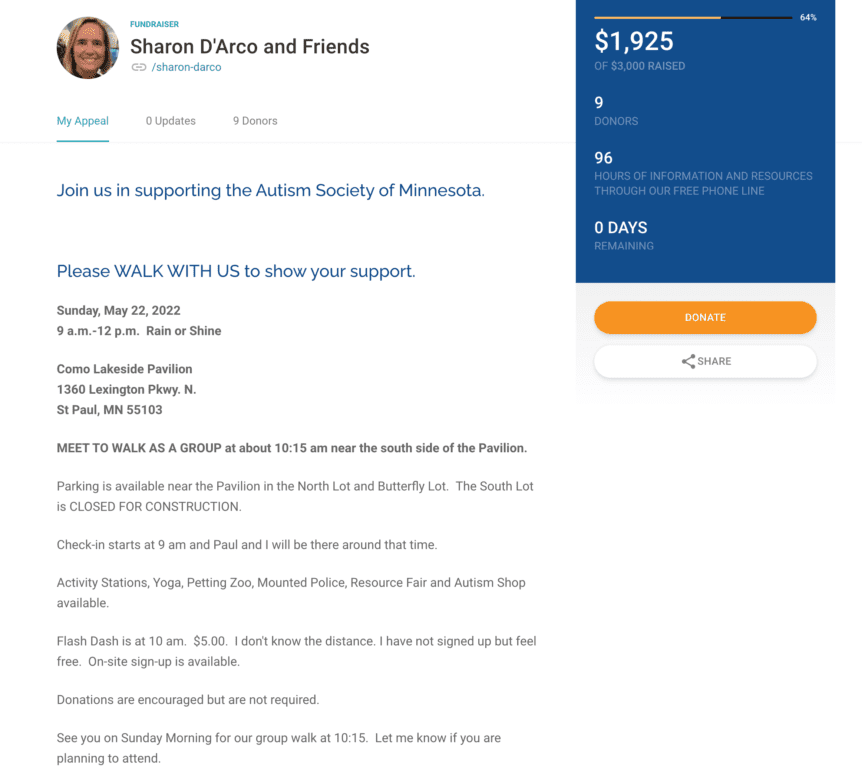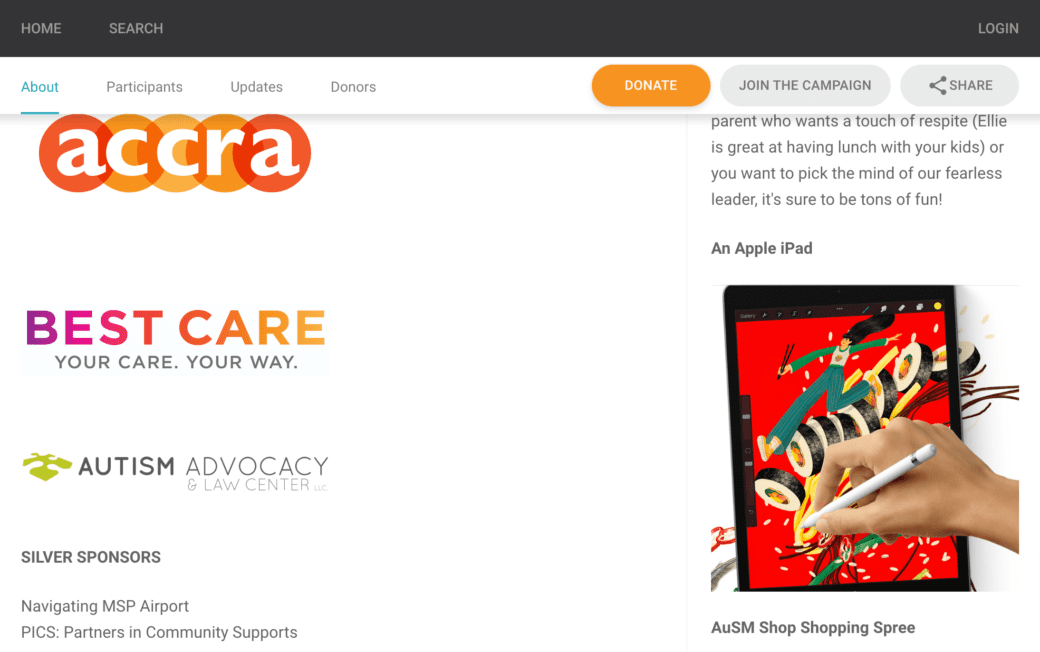Zephyr James is not your average CauseVox user: they have a bit of an unfair advantage, because they wrote CauseVox education materials for years. So when their day job employer, the Autism Society of Minnesota (AuSM), decided to start using CauseVox for their peer-to-peer fundraising, Zephyr was all in.
Here’s where it gets juicy: Zephyr sat down with CauseVox and dished some of their top tips and tricks for fundraising through CauseVox. As a fundraiser and a marketer, your work tends to overlap. In their role as Community Engagement Manager at AuSM, Zephyr used clear communication, robust toolkits, and strong marketing strategies to create successful fundraisers.
We recently sat down with Zephyr to hear the insights they learned from their Steps for Autism event on CauseVox. Read on to get an inside look or watch it in webinar form here!
AuSM Uses CauseVox for Their Annual Walk and Resource Fair
The Autism Society of Minnesota (AuSM) is an organization that’s been around for over 50 years, with a mission to enhance the lives of individuals and families affected by Autism Spectrum Disorder. AuSM serves Minnesotans, throughout their lives, with a fundamental commitment to advocacy, education, support, collaboration, and community building.
AuSM runs a number of fundraisers throughout the year, but in 2022 they decided to use CauseVox as the platform for their single biggest fundraiser of the year: Steps for Autism. This event centers around peer-to-peer fundraising, with supporters creating pages and teams to raise money for AuSM’s programs and services. At the end of the fundraising period, the community comes together for a fun walk, giant resource fair, and community activities.

Not only is it a huge fundraiser, it’s also an amazing opportunity for the community to come together and make connections. Check out how they made it a success using great communication, careful investments, and the features of the CauseVox platform.
The Intersection of Marketing and Fundraising
Zephyr has a background in marketing, so it’s not a surprise that we asked them about marketing and fundraising intersect: especially when we’re talking about digital fundraising.
“The language that we use is vitally important to our fundraising efforts. How we talk about what we do, what messages we send, when we communicate them, who we communicate them to. Those are all the things that a fundraiser does and those are all the things that a marketer does,” says Zephyr. When it came to working on Steps for Autism, their marketing skills played a huge role.
Zephyr’s biggest tip for small and medium nonprofits is to empower your fundraisers and donors. How? Communicate with them. Then communicate more. And then…communicate again. This is where the marketing element comes into play.
In any kind of fundraising, you’re building a relationship with your potential donors. That requires a strong message, good design, and effective communication across all the platforms you use. Especially when working with online donors, your role as a fundraiser is to share what you’re doing and how you’re fulfilling your mission so that donors understand what you’re doing with their gift.
In our current world, donors can do tons of research in advance before they decide to make a gift. That means that if marketing is doing its job to build relationships and share impact, fundraisers will have it easy.
“Every time I start a fundraiser I make sure that I have a toolkit for my fundraisers, I make sure that all of the information about my event, about my campaign is really easily available in multiple places. I make sure I’m in constant communication with them,” shares Zephyr. Each of these is an important element.
Peer-to-Peer Fundraising Toolkits
Creating a toolkit for your peer-to-peer fundraising campaign isn’t just a nice-to-have. It’s an essential part of preparing your fundraisers to meet their goals, so they in-turn can help you meet yours. You have years of experience in fundraising, and while your supporters may be enthusiastic, it can be daunting for them to try fundraising when they don’t have your background.
A peer-to-peer fundraising toolkit is not only useful for giving fundraisers the resources they need to promote your cause and successfully participate but also to ensure that you maintain your cohesive brand identity while they do so.
So what is a toolkit? It’s one place where you provide all the information your fundraisers might need. From your logo and campaign hashtag, to sample posts and scripts, to printable materials and essential language about your campaign, the toolkit distills all the insights you have as a fundraiser into one easy-to-find resource.
You can also supplement your toolkit by offering coaching sessions to your fundraisers: set a time when you’ll be available on Zoom or by phone so your fundraisers can get help setting up their page, writing an ask, or understanding the campaign.
Not only is a toolkit incredibly helpful to your fundraisers, it also gives you a reason to continue communicating with them throughout your campaign, which is one of the other elements Zephyr mentions as essential for both fundraisers and donors.
Continue Your Communications
In addition to your toolkit, there are plenty of other communications you can offer. Set up a welcome email that automatically sends whenever someone signs up as a fundraiser with a link to your toolkit and information about who your fundraisers can reach out to if they have questions or need support.
Follow up with a personal email welcoming them to the campaign. One of the best things about creating a toolkit is that it’s not a one and done piece: you can repurpose it over and over again.
Whether you’re talking to donors or fundraisers, remember that you need to share the same information multiple times. Not everyone will read every email, social media post, or website page. And even if they do, repetition helps to cement the ideas in their memory. Don’t be afraid to reuse content: you can always make small adjustments to make it seem fresh.
Zephyr shares that they’ve been working on repurposing elements of their toolkit as follow up touch points throughout the campaign.
“We send them the full PDF. Maybe they don’t open that email. Maybe they open it and think ‘This is too many pages. I don’t want to read that.’ So instead of relying on our fundraisers to do all that work because they are busy and they’re already volunteering their time, I go ahead and pull out an insight from that toolkit and send an email to all my fundraisers this week and say: ‘Hey did you know that you’re going to raise more money if you add a custom photo to your donation page?’”
The goal is to take all the wisdom that you’ve earned from years as a fundraiser and share it with your fundraisers to create mini versions of yourself out there fundraising for your cause.
Finding the Right Technology
Of course even if you are doing everything right with your fundraisers, if it’s hard to make a donation or your website is confusing, your campaign is going to struggle. That’s why it’s so important to find the right technology.
Zephyr’s first insight is to invest wisely. “We pay someone to design our logo and then I just reuse pieces from it. Don’t be afraid to spend a little bit of money on the base of something and then keep repurposing it and building off of it.” This applies to way more than design: investing in good technology or resources gives you a solid foundation that will pay off in the future. The secret is identifying where you need support and where you feel confident doing the work yourself.
One great example of this is CauseVox: while there is a free option, by spending to get the Standard Plan, you get a ton of support from the CauseVox team, who can help you throughout the process of your campaign. You may be a master of working with major donors, but if you need some support around structuring your marketing plan, CauseVox has tons of resources that can help you along the way. This one investment goes a long way.

Choosing Your Platform
Another element of technology is finding the right platform for your organization and community. Think about what features you would like to use in your campaign, and make sure your platform has them. One that Zephyr found incredibly helpful was CauseVox’s impact metric. The Impact Metric is an automated counter set to show the impact of your nonprofit crowdfunding or peer-to-peer campaign as it progresses, based on a unit of impact that you create in your site settings. It helped Zephyr’s team really drill down to see the core of what they do so that they could share it with their community (and you might want to check out the webinar for the story of where they found their perfect metric).
The impact metric also helped to focus the team on an important element when setting up thetechnology: find as many ways as possible to share your impact so that your donor understands how you’ll use their gift. This can be your impact metric, it can be the images you choose, it can be your donation tiers, or it can be in the main body copy you write on your page.
AuSM found that CauseVox was especially helpful in showcasing their impact because of the myriad of features. It was easy for staff and fundraisers to highlight and personalize in ways that excited donors, from sharing individual stories on personal pages, to making use of the sidebar, to highlight raffle prizes.
Working with Sponsors
Of course individual donors aren’t the only part of a fundraising event. AuSM’s Steps for Autism event also included sponsors, which can be a powerful way to increase the income of an event. If you’re new to the sponsorship game, here are Zephyr’s top strategies for making things easy for your sponsors.

Create Sponsorship Package Options
If you hold multiple events or campaigns throughout the year, chances are some of your sponsors will support more than one of them. A great way to decrease the amount of work you need to do and make life easy for your sponsors is to create ways for them to sign up for more than one opportunity at once. AuSM does this in two main ways: they have a Premier Partner program for organizations and businesses that support them throughout the year. Each partner gets a personalized package with discounts and unique sponsorship opportunities. In addition, they also offer sponsorship packages. They’ve paired similar events together and offer the chance to sign up for two or three events at once for a bonus virtual ad.
Not only do these discounts and specials make it more enticing for sponsors to get involved throughout the year, it also means that when you gear up to start soliciting sponsors for a new event, you already have a few supporters signed on, which can feel much better than starting with a blank slate.
Offer Benefits That Match Their Needs
There are almost endless ways to recognize your sponsors. When you’re planning out your sponsor benefits, one of the best things you can do is take time to ask your sponsors what’s important to them and tailor the benefits to match their needs. AuSM found that most of their sponsors were incredibly excited about getting face-to-face time with the community, and so all of their sponsorship levels included a resource table at their event. If you’re working with more corporate sponsors, you may find that it’s important to them to have a way to engage their employees: consider offering volunteer options for team-building. If you have other nonprofits sponsoring your event, how does the sponsorship connect with their mission?
Zephyr recommends starting from what drives the sponsor and creating sponsor perks from there.
Get To Know Your Sponsors
Of course you might be wondering how you determine what drives your sponsors. That’s where Zephyr’s final sponsorship tip comes into play: take the time to get to know your sponsors. Just as with a major donor, each sponsor is going to have different priorities and values. Chatting with them on the phone, in person, or over email will start to give you insight into what’s important to them. Especially for sponsors who return year after year, check in with them after each event and see what they liked or didn’t like so that you can tailor your future opportunities to what they want.
The Top Tip
Across all these areas, we asked Zephyr for one top tip for fundraisers. Their advice? “Don’t be afraid to ask more often.” It’s incredibly common for fundraisers to be nervous about irritating their donors by asking too much. Data shows that it’s important to communicate with your donors at least once a month, and that the best time to ask for the next donation is right after the previous one. Chances are, you have some space to increase your communications and asks before you’ll be inundating your donors. No matter what type of campaign you’re running, make sure you’re reaching out to your donors regularly.
Get started for free using peer to peer fundraising with CauseVox!
Put Zephyr’s tips to work and get started with CauseVox today! You can set up your peer-to-peer fundraising campaign in minutes, with features like the impact metric, easy fundraiser communication, and more.
Editor's Picks
Ultimate Guide To Peer-to-Peer Fundraising
Customer Story: Spur Local Raises Over $1M With Their Give Local Campaign
Fundraising Strategies for Nonprofits: Craft the Best Approach for Your Organization
Create a Killer Fundraising Plan - Best Practices, Strategies, & Downloadable Template



